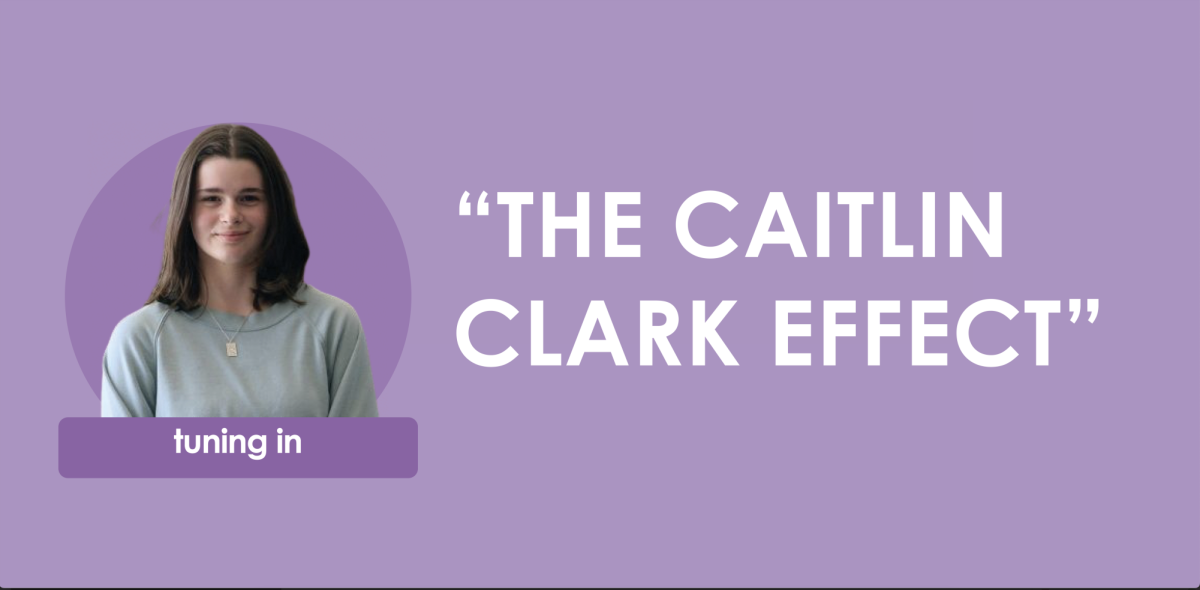Women’s basketball started off strong this year; two months ago during the March Madness season, the final women’s game absolutely destroyed the men’s in viewer count. According to NPR, South Carolina’s Gamecocks vs. University of Iowa’s Hawkeyes garnered 24 million eyes compared to the roughly 15 million that watched the men’s Uconn vs. Purdue match.
This phenomenon is owed partly to the “Caitlin Clark effect” as Indiana Fever’s new draftee took the league by storm right from the start. Even teams such as the Connecticut Suns who have enjoyed historically high ticket sales in the past are seeing drastic changes; their season ticket sales have roughly doubled for 2024 and May 14’s season opener against Indiana Fever quickly sold out as reported by the Sports Business Journal.
I represent my home state Connecticut and was disappointed when the Uconn Huskies lost to Clark’s Hawkeyes during March Madness. But, Clark is an undeniable household name and I’ll be tuning in to Indiana Fever games from now on.
While these developments are exciting and bring me great joy to see unfold, I think we can all agree that women’s sports are often overlooked and quite frankly ignored as men’s sports hog the limelight. In fact, it appears that sports broadcasters are unequipped to accommodate a growing interest in the WNBA. Forbes released an article just last week reporting on the blunders in coverage of preseason matchups. The WNBA app and WNBA league pass only featured two out of four highly anticipated rookies: Clark and the Dallas Wings’ Jacy Sheldon. Chicago Sky’s Kamilla Cardoso and Angel Reese received no such coverage and fans resorted to a cell phone livestream of one of the people in attendance.
Now, this might not seem like a big deal especially since these were preseason kickoff games, however if we’re not careful, Clark can become an example of tokenism where a handful of players receive all the attention in an effort to appease the equity-hungry public.
These institutional discrimination go far beyond viewership; pay disparities also exist. Statistica reports that the average NBA annual salary during the 2023-2024 season was 10.8 million dollars compared to a measly $116,000 for the WNBA. They’re playing the same game and women are simultaneously receiving less media and less pay for their efforts.
What’s more is the WNBA is inherently more dangerous for its players—a study published by the National Institute of Health (NIH) concluded that the WNBA had a game-related injury rate of 24.9 per 1000 athletes while the NBA sat comfortably at 19.3 per 1000.
The paper ends here, but in AP Seminar, I wrote my own paper about ACL injury risk for female soccer players and found that institutional discrimination such as a lack of medical research as well as obliviousness to different body composition and endocrine system based on sex were main culprits for high female ACL rates in professional soccer. I can only guess that the same issues may occur in women’s basketball, but from what I’ve learned so far that doesn’t seem to be an outrageous claim.
In short, the rise of Caitlin Clark and other promising rookies such as Jacy Sheldon, Kamilla Cardoso and Angel Reese garnered long-deserved attention for the WNBA. I can only hope that an increase in awareness and views correlate to a pay average that reflects the hard work of our players and not societal gender injustices.
The views in this column do not necessarily reflect the views of the HiLite staff. Reach Nora Mariano at nmariano@hilite.org.

































![AI in films like "The Brutalist" is convenient, but shouldn’t take priority [opinion]](https://hilite.org/wp-content/uploads/2025/02/catherine-cover-1200x471.jpg)










































![Review: “The Immortal Soul Salvage Yard:” A criminally underrated poetry collection [MUSE]](https://hilite.org/wp-content/uploads/2025/03/71cju6TvqmL._AC_UF10001000_QL80_.jpg)
![Review: "Dog Man" is Unapologetically Chaotic [MUSE]](https://hilite.org/wp-content/uploads/2025/03/dogman-1200x700.jpg)
![Review: "Ne Zha 2": The WeChat family reunion I didn’t know I needed [MUSE]](https://hilite.org/wp-content/uploads/2025/03/unnamed-4.png)
![Review in Print: Maripaz Villar brings a delightfully unique style to the world of WEBTOON [MUSE]](https://hilite.org/wp-content/uploads/2023/12/maripazcover-1200x960.jpg)
![Review: “The Sword of Kaigen” is a masterpiece [MUSE]](https://hilite.org/wp-content/uploads/2023/11/Screenshot-2023-11-26-201051.png)
![Review: Gateron Oil Kings, great linear switches, okay price [MUSE]](https://hilite.org/wp-content/uploads/2023/11/Screenshot-2023-11-26-200553.png)
![Review: “A Haunting in Venice” is a significant improvement from other Agatha Christie adaptations [MUSE]](https://hilite.org/wp-content/uploads/2023/11/e7ee2938a6d422669771bce6d8088521.jpg)
![Review: A Thanksgiving story from elementary school, still just as interesting [MUSE]](https://hilite.org/wp-content/uploads/2023/11/Screenshot-2023-11-26-195514-987x1200.png)
![Review: "When I Fly Towards You", cute, uplifting youth drama [MUSE]](https://hilite.org/wp-content/uploads/2023/09/When-I-Fly-Towards-You-Chinese-drama.png)
![Postcards from Muse: Hawaii Travel Diary [MUSE]](https://hilite.org/wp-content/uploads/2023/09/My-project-1-1200x1200.jpg)
![Review: "Ladybug & Cat Noir: The Movie," departure from original show [MUSE]](https://hilite.org/wp-content/uploads/2023/09/Ladybug__Cat_Noir_-_The_Movie_poster.jpg)
![Review in Print: "Hidden Love" is the cute, uplifting drama everyone needs [MUSE]](https://hilite.org/wp-content/uploads/2023/09/hiddenlovecover-e1693597208225-1030x1200.png)
![Review in Print: "Heartstopper" is the heartwarming queer romance we all need [MUSE]](https://hilite.org/wp-content/uploads/2023/08/museheartstoppercover-1200x654.png)




